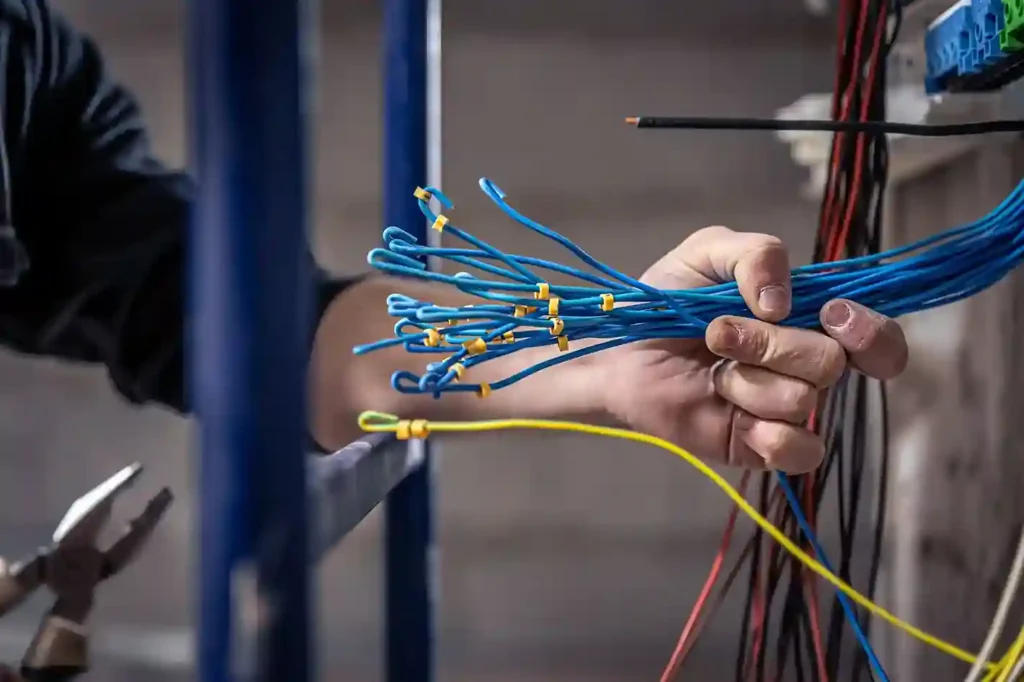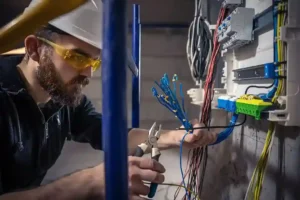Have you ever wondered how your smart home devices communicate seamlessly? The answer lies in low-voltage wiring, a hidden hero of modern electrical systems. Low voltage wiring is an essential aspect of modern electrical systems, playing a significant role in both residential and commercial properties.
From powering home automation systems to providing data transmission for networks, low voltage wiring connects various devices while ensuring safety and efficiency. It is distinct from high voltage wiring, as it typically involves voltages of 50V or less, making it safer to handle.
This article explores low voltage wiring in detail, covering its applications, installation techniques, and the importance of proper wiring choices for reliable performance.
What is Low Voltage Wiring?
Low voltage wiring refers to the use of electrical cables designed to carry a lower voltage, typically under 50 volts. Unlike traditional high voltage wiring, which powers larger appliances and systems, low voltage wiring is used for smaller devices, like lighting, telecommunications, and security systems. Low-voltage cables are built to handle less power, thus offering advantages in terms of safety and energy efficiency.
One of the key distinctions between low voltage and high voltage wiring is the amount of current that flows through the wires. High voltage wiring is used to deliver power to larger systems, while low voltage systems are intended for specialized applications. This makes low voltage wiring perfect for areas like home automation, where safety, control, and efficiency are paramount.
How to Identify Low-Voltage Wiring
When working with low-voltage wiring, the key is to check the volts being transmitted. Typically, products operate on 12V, 24V, or 48V. To ensure proper selection, you’ll need to pay attention to the gauge and thickness of the wire. For low-voltage applications, thinner wires like 12-gauge or 24-gauge are commonly used, as they are suitable for transmitting low amounts of electricity over short distances.

Low Voltage Wiring vs High Voltage Wiring: Key Differences and Identification
When you’re integrating new systems like smart home systems or installing outdoor lighting, it’s crucial to understand the difference between low-voltage and high-voltage wiring. These types of wiring play different roles in your home’s electrical setup and have different safety requirements. So, let’s break down how you can identify and work with low-voltage wiring and what makes it stand out from its high-voltage counterpart.
Appearance and Size
One of the first things to consider when identifying low-voltage wiring is its appearance and size. Typically, low-voltage cables are much thinner compared to their high-voltage counterparts. For example, cables used for ethernet like Cat5 or Cat6, and phone lines, are noticeably slimmer than the standard AC power cables you might see for home appliances. These cables are designed to carry less power, which makes them more flexible and easier to route in tight spaces.
Color Coding
Another easy way to distinguish between low-voltage and high-voltage wiring is by looking at the color coding. Low-voltage wiring often uses different colors to differentiate itself. For instance, network cables might be blue or green, while power cables typically come in black, red, or orange casings. This simple visual clue can help you spot low-voltage wiring when you’re observing your home wiring, ensuring you don’t mix up the systems.
Connectors and Connections
When working with low-voltage wiring, the connectors at the end of the wires are another big giveaway. Low-voltage wires often use connectors like RJ45 for network cables or coaxial connectors for TV satellites and cable connections. These connectors are much smaller compared to those used for high-voltage wiring, which typically requires larger connectors designed for AC outlets. Coaxial connectors and RJ45 are common for residential setups, making them easy to recognize.
Labeling and Specifications
Manufacturers of low-voltage wiring usually include specific labeling on the wire to help you understand its purpose. You’ll often see markings such as CAT6 for Ethernet cables or 18/2 for doorbell wiring. These markings indicate the voltage rating, gauge, and conductor count, so you know exactly what the wire is meant to handle. It’s always helpful to check these specifications to avoid any confusion, as not all wires are created equal.
Location and Safety
One of the biggest differences between low-voltage and high-voltage wiring is the location where they are used. Low-voltage wiring is often used in more accessible areas and is generally less risky to handle than high-voltage wiring. For example, Ethernet wires can easily be run along baseboards or through office cable tidies, which makes installation and future upgrades much simpler. This is why low-voltage wiring is typically found in less protected areas compared to the more dangerous high-voltage wiring.
Types of Systems That Use Low Voltage Wiring
Low-voltage wiring plays a crucial role in modern infrastructure, powering a variety of systems, whether for residential homes or commercial buildings. As our world becomes more connected, we rely heavily on these systems for everything from communication to security. Let’s dive into some of the key systems that benefit from low-voltage systems.
Telecommunication Systems
Whether in your home or business, telecommunication systems depend on low-voltage wiring to ensure smooth and reliable connections. Systems like telephone systems, internet, and Wi-Fi networks require Ethernet or fiber optic cables to connect devices. The bandwidth provided by these systems ensures fast, uninterrupted communication and connectivity.
For businesses, maintaining a strong network is essential to daily operations, and fiber optic cables are often the preferred choice for long-distance telephone and internet connections due to their high-speed performance and reliability.
Television and A/V Systems
Television systems in both residential and commercial businesses often require a combination of coaxial cable and fiber optic wiring to deliver high-quality signals. Whether it’s for a smart TV in a living room or a multi-screen setup in an office, A/V equipment needs consistent and high-performance wiring to ensure seamless viewing.
In a commercial setting, surround sound systems, smart TVs, and intercoms also rely on low-voltage wiring to deliver an excellent audiovisual experience. These A/V systems are essential for creating engaging environments, from restaurants to healthcare facilities, ensuring smooth operations and customer satisfaction.
Building Automation and Smart Systems
One of the biggest trends today is the rise of automation systems that use low-voltage wiring to power smart technologies in buildings. Whether it’s controlling lighting, adjusting temperature with thermostats, or managing energy efficiency, these smart features are transforming how we interact with buildings.
In addition to improving energy-efficient operations, structured cabling connects motion sensors, lighting controls, and security systems. In commercial buildings, structured cabling also helps optimize space by monitoring occupancy and managing temperature settings for comfort and efficiency.
Security and Access Control
Keeping a building safe is always a priority, and low-voltage systems are key to modern security products. Systems like security cameras, motion sensors, CCTV, and intrusion detection systems depend on low-voltage wiring to provide constant surveillance and immediate alerts.
For large-scale commercial buildings, Cat-6 cabling is often used to provide reliable connectivity for security cameras, ensuring clear images and high-performance monitoring. Similarly, access control systems, which use biometric scanners and card readers, rely on low-voltage wiring for secure and efficient operation. These systems can be integrated with security lighting and fire alarms to provide a comprehensive safety solution.
Safety and Emergency Communication Systems
In critical settings like hospitals, schools, or large facilities, low-voltage wiring supports paging systems, intercom systems, and mass notification systems. These systems enable rapid communication in case of emergencies, ensuring that safety protocols are followed promptly.
In healthcare settings, nurse call systems rely on low-voltage systems to alert staff instantly, whether through wireless phones, pagers, or real-time location devices. With EMR (Electronic Medical Records) integrated into the system, nurse call systems allow for faster response times and enhanced employee communication.
Automation for Home and Commercial Spaces
Another growing trend is the use of low-voltage systems for controlling everyday tasks, such as garage door openers and lighting systems. These automated systems rely on low-voltage wiring to function efficiently and add convenience to residential or commercial spaces. With the added layer of smart features, it’s now easier to control various systems through mobile apps or central control panels.
Additionally, fire alarms and carbon monoxide alarms ensure the safety of both homes and businesses, providing immediate notifications if danger is detected. All of these systems, while separate, can often be integrated using structured cabling, offering streamlined control for building owners and operators.

Low Voltage Wiring: Exploring Common Types of Cables
Low voltage wiring plays a crucial role in smart home technology and data networks. It powers and connects various systems in your home, keeping things running efficiently without the need for high-voltage electrical systems. When considering which cables to use, it’s essential to understand the different options available for low voltage wiring. Let’s look at some of the most common types used in these setups.
Twisted Pair Cable: A Foundation for Data Networks
One of the most commonly used types of low voltage wiring is the twisted pair cable. This cable consists of insulated wires twisted together to reduce electromagnetic interference and maintain a clear signal. It’s widely used in telecommunications and data networks, making it an excellent choice for home systems like smart home systems and advanced security cameras.
- CAT5 and CAT6 are popular examples of twisted pair cables, with Cat6 cables being particularly effective in providing higher data transfer speeds.
- These cables are also designed to handle 50 volts, which is perfect for most low-voltage applications.
Coaxial Cable: Ensuring Video Transmission Clarity
Another significant player in the world of low voltage wiring is coaxial cable. Known for its unique construction, coaxial cable has a copper conductor at its center, surrounded by an outer plastic layer that shields the signal. This design is particularly effective in video transmission, where signal clarity is paramount.
- Coaxial cable excels in environments with electronic interference, reducing the chances of signal disruption.
- It’s ideal for home entertainment systems or setups that rely on high-quality video feeds.
Shielded Cable: Protecting Signal Integrity
In environments with high levels of electrical noise, shielded cables are your best bet. These cables come with an additional layer of conductor material that helps block out interference, protecting the signal integrity. It’s an excellent option for installations where other electronic devices might cause electromagnetic interference.
- Shielded cable is often used in commercial or high-performance smart home systems that require precise, uninterrupted data and power transmission.
- This type of wiring ensures that systems like advanced security cameras receive a reliable power supply.
Fiber Optic Cable: Speed and Resistance to Interference
While fiber optic cable isn’t as commonly used in low-voltage applications for smart homes, it’s becoming more popular in high-end installations due to its outstanding performance. Unlike traditional copper cables, fiber optic uses light transmission to send data, offering superior speed and resistance to interference.
- The ability of fiber optic cables to maintain data integrity even in challenging environments makes them ideal for high-demand installations, especially when you need a secure and fast connection.
- This type of cable can be more expensive but is the go-to choice when you require a reliable power supply and consistent data transmission.
Key Considerations When Installing Low Voltage Wiring
When installing low voltage wiring, several factors must be taken into account to ensure both safety and performance:
- Planning the Layout: Before starting the installation, it’s crucial to plan the layout for the wires. This includes choosing the best routes for the wires and ensuring that all devices are properly connected.
- Choosing the Right Wire Type: Selecting the appropriate wire for your specific application is crucial. For example, coaxial cables may be best for media systems, while twisted pair cables are ideal for data transmission.
- Code Compliance: Low voltage systems still need to comply with local electrical codes, such as those set by the National Electrical Code (NEC). This ensures that installations are done safely and correctly.
- Safety Standards: Proper insulation, grounding, and protection against short circuits are essential for low voltage wiring to function safely.
- Wire Gauge and Distance Limitations: Different wires have varying performance levels based on their gauge and distance. For instance, higher gauge wires may lose power or signal over long distances, so it’s important to choose wires that meet the specific needs of your setup.
Tools and Techniques for Installing Low Voltage Wiring
The installation of low voltage wiring requires specific tools and techniques:
- Wire Strippers and Crimping Tools: These are essential for stripping the insulation off the wires and attaching connectors.
- Testing Equipment: Testing the wires for continuity and performance is crucial to ensure that the installation is successful.
- Installation Steps: Start by planning the wire layout, cutting the necessary cable lengths, stripping the insulation, and making the connections between devices. Be careful to avoid twists and bends in the cables that could cause performance issues.
Low-Voltage Wiring Safety Risks
When working with low-voltage wiring, it’s essential to prioritize safety to avoid serious risks. Here are the main concerns to keep in mind:
Fire Hazards
Overheating occurs when wires are bundled tightly or placed near heat sources like vents, increasing the chance of a fire. To prevent this, ensure cables are spaced out properly, and regularly check for damaged or frayed insulation.
Electric Shocks
Although low-voltage wiring doesn’t carry enough power for fatal electrocution, accidental shocks can still occur, especially if you handle bare wires with wet hands. Always use rubber gloves and make sure connections are insulated for added protection.
Signal Interference
Poorly shielded cables or those too close to high-voltage wires can cause signal interference, leading to malfunctions in smart home systems and false alarms in security devices. Use shielded cables and keep a safe distance from high-voltage lines to avoid cross-interference.
Code Violations and Legal Risks
Not following local building codes for low-voltage installations can lead to fines, system upgrades, or service disconnection. Always consult a professional and have an inspector review your setup to ensure compliance with regulations.
Advantages of Low Voltage Wiring
Low voltage wiring provides various benefits when compared to traditional high voltage systems:
- Cost-Effective: Because low voltage systems don’t require as much power, they are generally less expensive to install and operate.
- Safer: Low voltage wiring is safer to handle, reducing the risk of electrical shock and fire.
- Energy Efficiency: Low voltage systems consume less power, making them more environmentally friendly and cost-efficient in the long run.
Looking for a Skilled Electrician to Assist with Your Low-Voltage Wiring?
If you’re working with low-voltage wiring, it’s important to remember that even though it’s less dangerous than high-voltage wires, it’s still not something you should try to do yourself. It’s always safest to contact a master electrician who can ensure that your wiring is installed safely and in compliance with local building codes.
For over many years, Spark Edge Electric has been providing electrical services to retail, commercial, and industrial properties across Houston – just reach out to our team for a site visit and discuss your project and requirements.
FAQs
How does high voltage wiring differ from low-voltage wiring?
High voltage is typically used for powering larger equipment and systems, while low voltage is best suited for smaller devices and machinery. The key distinction between the two lies in the amount of power they carry, with low-voltage wiring being safer and more efficient for home systems like lighting or smart home devices.
Can I Use Cat6a Instead of Cat6?
Cat6A is a cost-effective option if you need a faster speed of at least 500 MHz and 10 Gbp/s up to 328 feet (100 meters). While Cat6 can handle 10 Gbp/s at 165 feet (55 meters) under ideal conditions, the difference in max speed and performance makes Cat6A the better choice, especially in areas with heavy crosstalk that can cause voltage issues, leading to crosstalk at both near and far ends of the wire.
Is 120V Considered Low Voltage?
No, 120V is not considered low voltage. In most electrical systems, low voltage typically refers to voltages under 50V. 120V is considered standard residential voltage in the United States and is classified as line voltage or high voltage in comparison to low-voltage systems, which are usually used for things like smart home wiring, network cables, and other small electronics.

